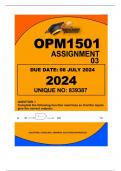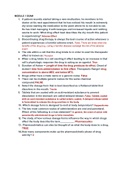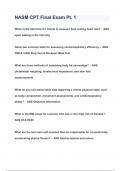,OPM1501 ASSIGNMENT 03
DUE DATE: 08 JULY 2024 @ 11:00 PM
UNIQUE NUMBER: 839387
Solutions:
a) Multiplication:
32 × ? = 224
To find the missing number, divide 224 by 32.
224
?= =7
32
b) Subtraction:
1080 − ? = − 960
To find the missing number, subtract 1080 from -960.
? = 1080 + 960 = 2040
,c) Division:
525 ÷ ? = 25
To find the missing number, divide 525 by 25.
525
?= = 21
25
d) Operation:
510 ? = 270
To find the missing operation and number, it is usually an integer subtraction, so
subtract 270 from 510.
? = 510 – 270 = 240
1.2. If you were asked to complete the following number line by filling in the
missing numbers, explain why it would not be possible to do so:
To complete the given number line, we need to identify a consistent pattern
between the numbers, such as a common difference or ratio. Here’s the given
sequence with the missing numbers:
19,--,31,--,--,42
Let’s analyze why it may not be possible to fill in the missing numbers
consistently:
Step-by-Step Analysis:
1) Identify the Intervals:
, The difference between 19 and 31 is 31−19 =12
The difference between 31 and 42 is 42−31=11
Thus, the differences are 12 and 11, which are not equal.
2) Patterns and Common Differences:
If we assume an arithmetic sequence (where each term is the previous
term plus a constant difference), the differences between consecutive
terms should be equal. Here, the differences are not consistent (12 and 11).
3) Incomplete Information:
Without a consistent pattern or additional information, there are multiple
possible ways to fill in the missing numbers. For example, one might guess
a pattern like + 6,+ 6, or any other non-linear pattern, but it won’t be
definitive.
4) Possible Sequences:
If we attempt a consistent pattern, we might consider a variety of different
sequences (e.g., arithmetic, geometric, or others). However, each trial would give
us different values for the missing numbers.
1.3. Provide two ways you can use to teach the students how to generate the
rule for each of the following:
To teach students how to generate the rule for each of the given input-output
pairs, here are two methods for each:
(a) 32 → × … → 224
1. Direct Calculation Method






